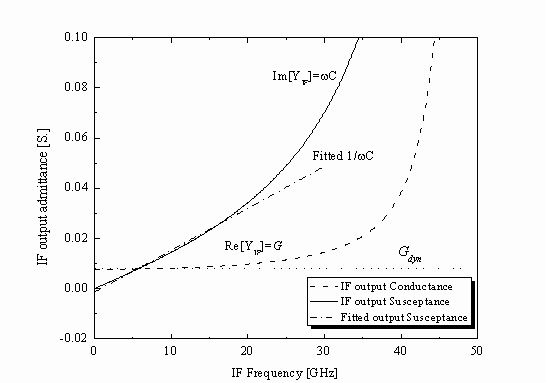
By with LIU Dong
Fig. 1. IF output conductance (dash line), susceptance (solid line) and fitted susceptance (1/ωC, dash dot line), dynamic conductance (the differential of the pumped IV curve at the optimum bias voltage, dot line).
Superconductor-insulator-superconductor (SIS) mixers, with sensitivity approaching the quantum limit, play an important role in radio astronomy and atmospheric research at millimeter and sub-millimeter wavelengths. Besides the mixer noise temperature, the intermediate frequency(IF) bandwidth is also an important parameter for heterodyne mixers. It is well known that sensitive SIS mixers of large IF bandwidth are particularly beneficial to the observation of continuum sources, measurement of the red-shift of distant galaxies, and simultaneous observations of multiple spectral lines.
The intrinsic IF bandwidth of SIS mixers is limited mainly by the capacitance originated from the SIS junctions and the integrated tuning circuits. The IF bandwidth of SIS receivers is limited also by the bandwidth of the cryogenically cooled low-noise amplifier, especially with an isolator included (e.g., ALMA, Herschel HIFI). With dedicated designs for SIS mixers and the advance of MMIC LNAs, SIS receivers based on Nb tunnel junctions have demonstrated IF bandwidth more than 10 GHz.
Low-noise NbN SIS mixers have been successfully demonstrated to be a promising coherent detector for submillimeter wave astronomy. In this paper, we mainly investigate the IF bandwidth characteristics of an all-NbN SIS mixer at 0.5 THz. The conversion efficiency and IF output impedance of the 0.5 THz NbN SIS mixer are theoretically calculated based on the quantum mixing theory to evaluate the mixer IF bandwidth. Furthermore, the mixer noise performance is measured in the IF band of 0.5 ∼12 GHz with and without an isolator, respectively.
The work by LIU Dong , LI Jing , WANG Zhan , YAO M. , HU J., and SHI Shencai (corresponding author), have been published on IEEE TRANSACTIONS ON APPLIED SUPERCONDUCTIVITY, VOL. 23, NO. 3, JUNE 2013. http://ieeexplore.ieee.org/xpl/articleDetails.jsp?arnumber=6407837 |
